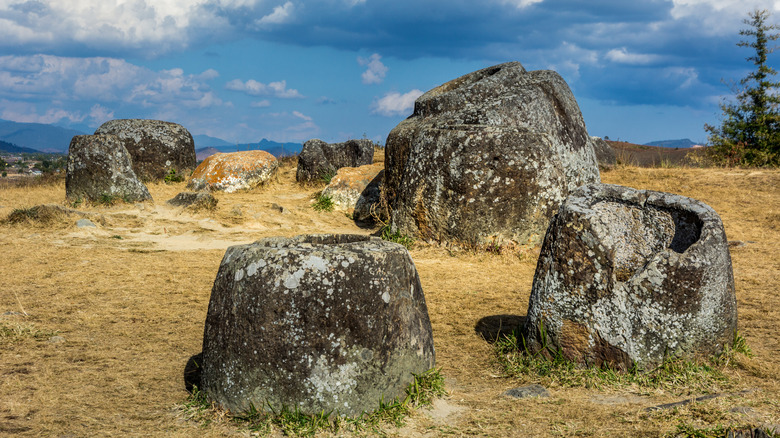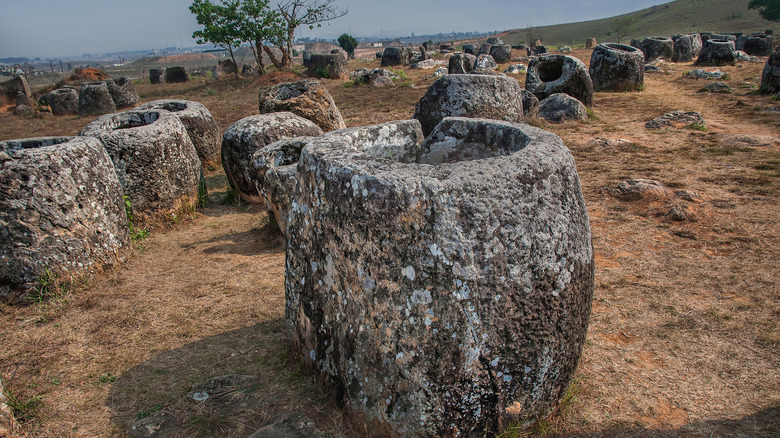'Asia's Stonehenge' Is One Of The Continent's Most Important Archaeological Sites With Dramatic Views
Asia is filled with some of the world's most iconic historic and cultural monuments, like the stunning statues at Cambodia's Angkor Wat or the epic remains of ancient Petra in Jordan. But hidden in the quiet landlocked nation of Laos, one of Southeast Asia's most underrated vacation countries, is arguably one of the continent's most important archaeological sites that you must visit.
The Plain of Jars, sometimes referred to by travel and tourism sites as Asia's Stonehenge, is an impressive and baffling collection of thousands of large stone jars that litter various fields in eastern Laos. The cryptic Plain of Jars sites have spawned legends of giants and theories of extraterrestrials, and they should definitely be a bucket list visit for anyone interested in Earth's ancient mysteries.
Not all of the jar sites are accessible to tourists. Due to military weaponry like unexploded bombs and mines throughout the country, only seven sites are safe to explore. Of those, the three principal viewing sites for tourists are outside of Phonsavan, a small city located far away from any international hub. For that reason, visitors will have to take a domestic flight into Phonsavan's airport if they want to see the mythic jars. Are you ready to visit this perplexing piece of the past?
The Plain of Jars is a historical mystery waiting to be uncovered
Exactly why there are some 2,000 stone jars dating to the Iron Age in the middle of Asia is still unknown. According to the BBC, Laotian myths claim they were the result of giants storing rice wine used during celebrations. More recently, it was long thought they were used for holding rainwater, although according to Archaeology Magazine, discoveries of human remains nearby suggested the jars were either used as "mortuary chambers" or for cremation. The magazine states that many locals believe the jars' origin is tied to an ancient legend of a king who celebrated a great victory with huge quantities of rice wine, though historians are skeptical. As with Stonehenge in England, many also believe the jars have spiritual or otherworldly origins.
The Plain of Jars has been intriguing archaeologists for decades, though attempts to study its history have been hampered since the 1960s due to military conflict across Laos. Some of the unexploded bombs scattered across the Laotian jungle were dropped by American planes. Over the years, explosives experts have created carefully curated tracks at the principal Plain of Jars sites that you must follow while visiting and not step away from for your own safety.
Explore the region's disturbing history
Going to all three sites of the Plain of Jars is definitely ideal for a curious traveler, but for tourists on time constraints, definitely stop by Site 1. It's the largest site, and home to the biggest jar, along with being the closest to Phonsavan as well.
You can support landmine excavation in Laos and the Plain of Jars. Visit the museum at the UXO Visitor Information Center in Phonsavan, run by the British Mine Advisory Group, and arrange a tour with the group where proceeds help fund the removal of explosives. You could also directly donate at the information center. Most tours also include a visit to Ban Napia, known as the War Spoon Village. This local village uses wartime debris to build household items, with artisans who melt down weapons to create goods to sell to travelers. In Phonsavan, history buffs shouldn't leave without checking out the Vietnam War Memorial and the Lao War Memorial as well.
Those interested in traveling further within Laos, head over to the Mekong River. It might be one of the most dangerous rivers in the world, but it's also the country's most iconic landmark. If you're planning on continuing your travels in Asia beyond Laos, definitely peruse Islands' list of the 10 best lesser-known attractions in Asia, according to travelers.


